Nokia Lumia 830 Review
by Brett Howse on November 25, 2014 8:00 AM EST- Posted in
- Smartphones
- Microsoft
- Lumia
Display
Features such as two-stage camera buttons, multiple microphones for noise cancellation and surround sound video recording, and LTE connectivity are all great, but the one thing you use on any smartphone the most is the display. This means that a good display is something that all manufacturers should focus on. The improvements to smartphone displays over the last several years have been pretty dramatic, but it is still one area where a phones with similar internals can differentiate themselves from the competition.
The Lumia 830 has a five inch 1280x720 resolution IPS LCD. The Lumia line has alternated between Organic LED displays and Liquid Crystal Displays for many of their models. This particular device did end up with a LCD though, which brings the strengths and weaknesses of LCD along with it. Generally, color reproduction is better on a LCD but black levels and contrast cannot match OLED displays, with only the most recent Samsung OLED panels bucking that trend. The resolution of the Lumia 830 is a bit off the 1080p displays we see on higher end phones, but at 294 pixels per inch it is reasonably sharp and falls just under the iPhone 6 and its 326 pixels per inch.
As you can see in the above image, another advantage of LCD is that they are generally a RGB stripe, so there are no extra pixels or pentile matrices to deal with.
As with the Lumia 930, the Lumia 830 also supports “sunlight readability enhancements” which is a method of doing per pixel based content-adaptive backlight control from Apical which helps the perceived image when the device is used outdoors. The brightness is much higher on the 830 than the 930, but these additions can make the device much more usable outdoors.
One of the issues I had with the Lumia 630 when I reviewed it was the display had an almost matte texture to it which caused your finger to catch and drag when using the touchscreen. The Lumia 830’s ClearBlack display suffers none of this, and has a wonderful smooth coating on it which is also easy to clean. One other feature that seems to be somewhat exclusive to Lumia phones is Super Sensitive touch which allows the device to be used with gloves on and still interact with the touch screen. As you will see in the upcoming camera section, this is appreciated in colder climates.
To test the display accuracy, we turn to Spectralcal’s CalMAN 5 software package with a custom workflow. We utilize the X-Rite i1Pro Spectrophotometer for color accuracy and saturation, and the X-Rite i1Display Pro for contrast ratios.

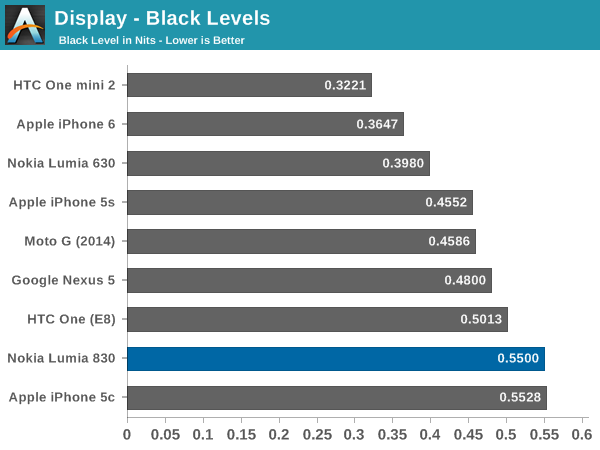
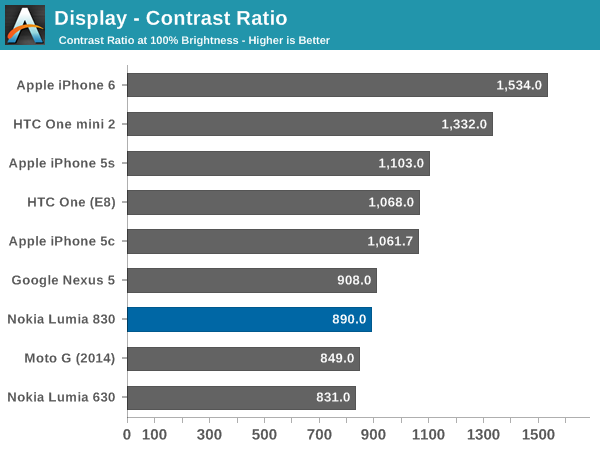
At almost 500 nits, the Lumia 830 is plenty bright for most situations. However the relatively poor black levels result in a contrast ratio that is not spectacular. The black levels are the one thing I noticed while using this device especially when my daily phone is OLED.
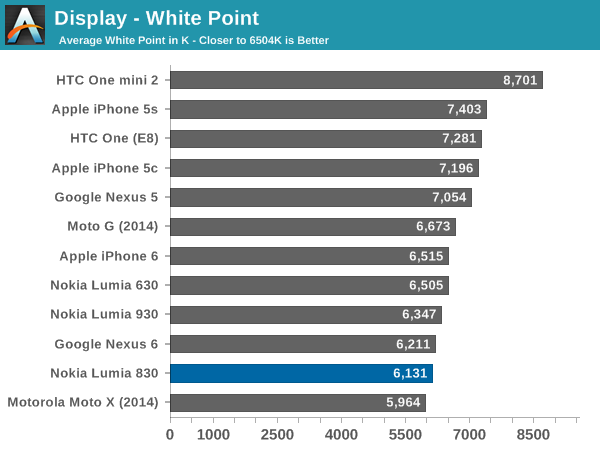

The white point on the Lumia 830 is a bit under what we would be looking for, however you can see from the Calman results that the green starts to shift quite high as the white level rises. That combined with the blue falling away results in a less than amazing 5.207 grayscale average dE2000 score. It is not a great result especially when compared to the Lumia 630, which was one of the better scoring phone displays we have tested and is in a much cheaper device from the same manufacturer. It is clear that the Lumia line has not yet taken display calibration seriously.
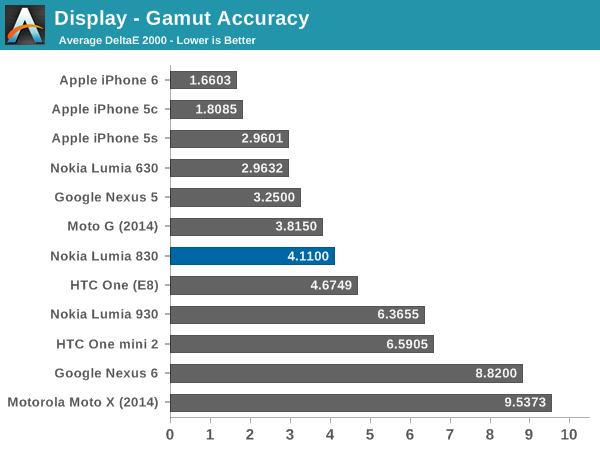
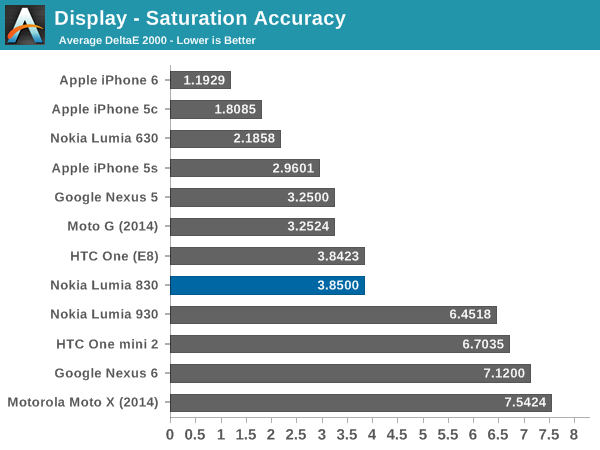
The saturation sweeps are a bit better than grayscale. We are looking for values under 3, and the Lumia 830 is not too far off this mark. At 3.85, it is still quite a way from the Lumia 630’s 2.18 though.
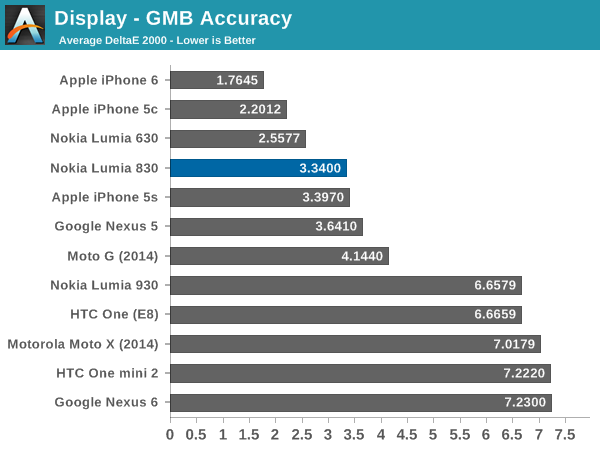
The Lumia 830 does fairly well in the GMB checker, despite the poor grayscale. It comes in with a good, but not great result, and still falls short of the Lumia 630.
The Lumia 830 does support the recently added options for an advanced color profile, which will allow a user to adjust the display to one of three presets (Standard, Vivid, Cool) or to choose Advanced and manually adjust color temperature, tint, and saturation. We are still without a mobile operating system with full color profile support, but this is a good step in the right direction.
Using these settings, you should be able to pull the green down a bit in order to correct the display. The disappointment is that the display is not correct when it leaves the factory though.
The Lumia 830 ends up with a middle of the road LCD. Black levels are not the greatest, but the overall accuracy of the display is not so far off the charts as to be unusable either. The white point is a bit low, but better than some displays which come from the factor with a huge blue shift.


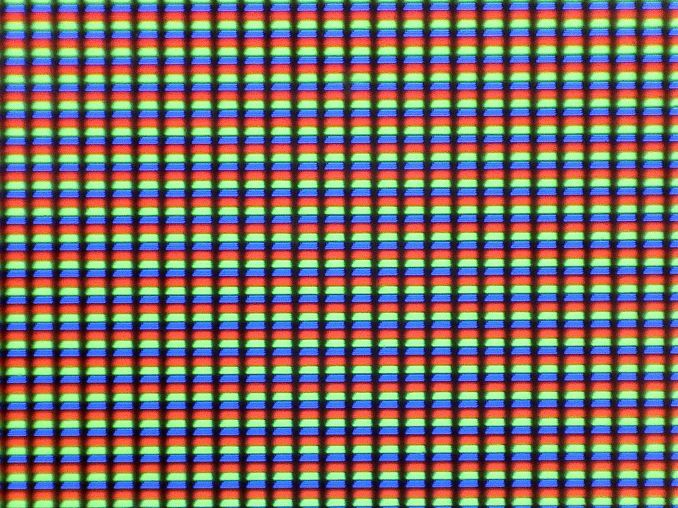



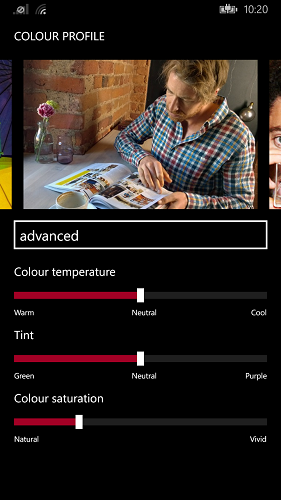








98 Comments
View All Comments
TheFlyingSquirrel - Tuesday, November 25, 2014 - link
The phone would have been so much more compelling if this came out last year or even more 1st half of the year before the newer Qualcomm chips started showing up in mid-range devices.PubFiction - Tuesday, November 25, 2014 - link
You can pretty much chalk up almost every windows phone to this same statement, would have been good if it was 6 months to a year earlier. They seriously cannot expect to do anything with their last place priority for phone development.tralalalalalala40 - Tuesday, November 25, 2014 - link
It's silly to mention megapixels when comparing cameras. By eye, a camera would have to be 4*8= 32 mp to be obviously better than an 8mp camera. What matters is more is sensor size/light intake/signal to noise/etc which has nothing to do with mp. (hint, 1080p is less than 2 megapixels...)ToTTenTranz - Tuesday, November 25, 2014 - link
I don't think Qualcomm sells the Snapdragon 600 in large quantities anymore, probably because the final price ended up too close to the Snapdragon 800/801, since it required an external baseband processor. My guess is the FireTV is the last "new" device getting those chips, as it doesn't need the extra baseband processor.I understand that getting the S610 could be too early for this Lumia 830. Though it's harder to understand why they didn't use the S410, since there are already lots of devices on the market using it and it's quite a bit faster than the old S400.
This makes me think that the Lumia division is still suffering from the same "inertial" problems as the old Nokia. This model would've made total sense during last year when the Moto G was reigning over the mid-end market.
Drumsticks - Tuesday, November 25, 2014 - link
I thought that the 830 was too early for S610 as well, but it's already available/shipping in several HTC Phones (their desire line or something?) and presumably some other OEMs as well.cheshirster - Friday, November 28, 2014 - link
What is the point in S410? It is not faster.S600 is older then first gen WP8 phones( 920 and 820). Imagine Nexus 4 battery life tests instead of actual L830 numbers and you will understand why it has S400.
simard57 - Tuesday, November 25, 2014 - link
I recently swapped my original Moto X for a Lumia 830. The X was my third Android phone and this is my 1st Windows Phone. I am pleased with the 830 and feel it gives me a longer time between charges than my X did. Having a replaceable battery is a nice perq as well.One "issue" I have stuggled with is a way to import my google favorites from google Map. I exported the favorites into a KML file and was able to import them into www.bing.com/maps but regrettably, the web Bing Maps do not sync with Windows Phone Maps or Windows 8.1 Maps. I googled it and learned that Phone Maps syncs with Windows 8.1 Maps - and it does BUT there is no apparent way to import a KML file (or any file) into the Windows MAPS or Phone MAPS program. Please do not tell my I have to manually enter each of the entries!
What's up with that Microsoft? This IS a required feature!!!
cheshirster - Friday, November 28, 2014 - link
Phone maps sync with here.com. Maybe this would help.simard57 - Monday, December 1, 2014 - link
is there a way to move my location library from the Google ecosystem into the Microsoft one?I will keep looking - but I do not see a way to import KML or any file into here.com
simard57 - Monday, December 1, 2014 - link
also - does here.com sync with windows 8.1 maps?sure feels like the maps situation in the Microsoft ecosystem is bit fragmented.